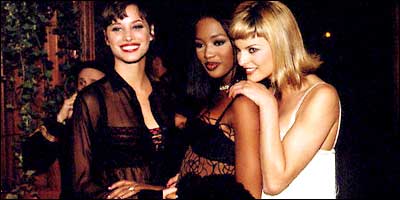BEAUTY 1986

The Trinity: Christy, Naomi, and Linda looking fabulous. Photo credit: Corbis
The word Supermodel was always out there, begging to be coined. Back in the forties, a small-time agency boss named Clyde Matthew Dessner tried tossing it around; in the seventies, Janice Dickinson, the bad-girl queen of the Studio 54 era, attempted to claim it all for her own. But it wasn’t until the late 1980s that a new crew of world-historical mannequins took over New York and became so monumentally fabulous that even jaded fashion pros began using the term without a hint of irony.
It all started quietly enough. In 1986, photographer Steven Meisel, hairstylist Oribe Canales, and makeup artist François Nars imported a California teenager named Christy Turlington into Meisel’s Park Avenue studio to shoot her for British Vogue. Within days, Turlington introduced Meisel to a teenage Brit named Naomi Campbell, and he in turn introduced her to a forbiddingly sleek Canadian named Linda Evangelista. “The Trinity” was born, and was soon a sensation on the runways and nightclub dance floors of New York. Christy, Naomi, and Linda. (The true supermodels were known on a first-name basis. Sorry, Stephanie. Sorry, Kristen.)
Cindy, an athletic, and unusually American-looking, model from Illinois, was the only other girl to commonly go last-nameless. In 1989, fashion photographer Albert Watson flew out to San Francisco to shoot a campaign for the label Blue Marine. “We were shooting in Chinatown, and a bunch of young GIs drove by in this open convertible,” Watson recalls in his dewy Scottish lilt. “Cindy was standing there in the middle of the street, and one of the guys noticed who it was. The guy driving slammed on the breaks; all the traffic literally screeched to a halt. They were screaming and shouting, ‘Give it to me, baby,’ and all that. Cindy was smiling. She was always very cool about stuff like that. But the point of the story is just that this was a fashion model—it wasn’t Nicole Kidman—but still, a bunch of GIs driving through San Francisco knew instantly who she was.”
“Magazines created the supermodels by putting their names in the editorial,” says Watson. “But this whole phenomenon didn’t just serve the magazines’ interest. The supermodels emerged at a time of intense competition between the model agencies. So each agency would say, ‘Look, you can have Cindy Crawford, but we want her name on the cover.’ ”
By mid-decade, Cindy was keeping her House of Style on MTV, Linda was having a hard time getting out of bed for less than $10,000 a day, and authorities ranging from Karl Lagerfeld to Time magazine had declared the supermodels more glamorous than movie stars. This made the reverse crossover inevitable, of course, and soon, Melanie Griffith had a Revlon print campaign of her own.
Enormous exposure, of course, brought enormous responsibilities. For a time, Linda seemed to issue a cultural salvo with every droll comment. On the town one night in 1990, she joked, “We don’t ‘vogue’; we are vogue.”